Birding the Dry Tortugas in late April has always been high on my bucket-list of the best birding experiences in North America. Now before any of you think that I must be really old or dying to have a bucket-list I must assure you that before April 9th 2012 I was still in my thirties. That means I used to be very young. Almost infantile. Now I’m just young. And last week I got to celebrate my coming of (young) age by crossing one off the old list, courtesy of my mate Adrian Binns and Wes Biggs of Florida Nature Tours. The birding was epic thanks to a superb fall-out the day before we left Key West and I’ve gotta spout that this has been the very best birding I’ve had in Florida in 4 years.
Even if conditions are not favorable for a fall-out and you’re not as lucky (or as young) as me, there is bound to still be a steady stream of migrants if you visit during mid-April to early May. Day-trips to the Dry Tortugas are of course possible but the best way to experience the islands is on an extended 3-day guided tour. This way you can bird some of the keys surrounding Fort Jefferson and also increase your chances of a fall-out.
 Loggerhead Key, just west of Fort Jefferson, can produce incredible and unusual birds
Loggerhead Key, just west of Fort Jefferson, can produce incredible and unusual birds
Our Tortugas adventure really began in earnest on the drive down to Key West where we started noticing unusually large concentrations of songbirds. Also in attendance were a few Peregrine Falcons and the ubiquitous ospreys. A fresh westerly wind had grounded a significant biomass of birds and I felt overjoyed at the prospect of exhausted and dying birds. And we’re supposed to love birds. Right? Wrong. Severe fall-outs, whilst the nightmare of migratory birds, are like manna from the heavens to any self-respecting birder and this one was proving to be no different.
 Osprey snacking on its slippery prey
Osprey snacking on its slippery prey
On arrival in Key West we headed straight for Fort Zachary Taylor State Park and were astounded at the sheer number of birds but most especially the warblers. They were everywhere and we were lucky to nail down some nice species including Prothonotary Warbler and a very confiding Kentucky Warbler.
After some very rewarding birding at Fort Zachary we headed straight for Indigenous Park. These quaint grounds were literally hopping with songbirds of all sizes, colors and songs. Highlights were Blue-winged Warbler, a first for me in Florida. We birded Indigenous Park until sunset and boarded the boat that was to ferry us to the Dry Tortugas the following morning. Not only did we already have an incredible 22 warbler species in the bag from one afternoon’s birding but we also got crippling views of dozens of other species including both Scarlet Tanagers and Summer Tanagers.
 Blue-winged Warbler, a scarce bird for Florida
Blue-winged Warbler, a scarce bird for Florida
 We had three of these male Scarlet Tanagers flitting about in one tree
We had three of these male Scarlet Tanagers flitting about in one tree
 A female Summer Tanager at Indigenous Park, Key West
A female Summer Tanager at Indigenous Park, Key West
The 70 mile boat-trip over to Garden Key is really a mini pelagic trip. A notable species that we missed close to Key West, where they are normally spotted on markers, was the wonderful Roseate Tern but as we headed further out we picked up the first Brown Boobies, Bridled Terns and Audubon’s Shearwaters along with the odd Northern Gannet and the more common Royal Terns, Magnificent Frigatebirds and Laughing Gulls.
 Brown Boobies like to sit on the markers and buoys
Brown Boobies like to sit on the markers and buoys
Sooty Terns are generally seen closer to the Tortugas and this trip was no exception. They nest in their thousands on Bush Key, close to Fort Jefferson, the largest brick structure in the Western Hemisphere built in the mid-1800’s. Over 16 million bricks. Now that’s a lot of bricks for an unfinished fort. A cynic might say, “Good thing the US government has learnt from this mistake and now spends money more wisely”. But that cynic is not me. Green cards can be taken away at any time. And besides, I’m glad they spent money on one of the best migrant traps in the Western Hemisphere.
Close to this shining example of un-wasteful spending, we saw our first Masked Boobies of the trip on Hospital Key. This small sandbar is the only place in the US where Masked Boobies nest. For their sakes I hope they don’t get on the wrong side of any high tides!
 A Sooty Tern crests the waters off the Dry Tortugas
A Sooty Tern crests the waters off the Dry Tortugas
 Fort Jefferson, the largest masonry structure in the western hemisphere
Fort Jefferson, the largest masonry structure in the western hemisphere
 Hospital Key, the only nesting site for Masked Boobies in the US
Hospital Key, the only nesting site for Masked Boobies in the US
Our good luck with the back-end of the fall-out persisted when we arrived in the Dry Tortugas. We were fortunate to get off the boat at Loggerhead Key, the largest of the islands, and birded the key for the afternoon. The great thing about the Tortugas at this time of the year is that you never know what to expect. Almost anything can show up as demonstrated by a worse-for-wear Roseate Spoonbill that was desperately trying to sift through beach sand to feed. Now that’s probably the equivalent of humans trying to eat bark to survive. Yellow-billed Cuckoos were everywhere. An Upland Sandpiper wandered next to the lighthouse. Merlin and Peregrines joined us by taking advantage of the bountiful bird supply.
The bizarre and unusual continued as we birded Fort Jefferson the following days. A strange warbler had birders flummoxed. It appeared to be a partially leucistic male Hooded Warbler with the strangest colors imaginable.
 The weird and wonderful Hooded Warbler
The weird and wonderful Hooded Warbler
Garden Key and Fort Jefferson had some wonderful birds. The wrack-line outside the fort held White-rumped and Pectoral Sandpipers as well as the more common shorebirds and an exhausted Sora Rail. Rose-breasted Grosbeaks flaunted their gaudy colors like topless sunbathers on a beach in the south of France. An unusual bird that is seldom seen on the Dry Tortugas was a solitary Lincoln’s Sparrow. We added a few new warblers to the list including Cerulean and Wilson’s Warblers. There were several nighthawk sightings, some better candidates for Antillean Nighthawks than others.
 White-rumped Sandpiper in the wrack-line
White-rumped Sandpiper in the wrack-line
 The White-rumped was foraging with a nice Pectoral Sandpiper
The White-rumped was foraging with a nice Pectoral Sandpiper
 Rose-breasted Grosbeaks fighting over an insect
Rose-breasted Grosbeaks fighting over an insect
 Lincoln’s Sparrow has only been recorded here a few times
Lincoln’s Sparrow has only been recorded here a few times
 Although we didn’t hear it call, this is a good candidate for Antillean Nighthawk
Although we didn’t hear it call, this is a good candidate for Antillean Nighthawk
 Grey and Eastern Kingbird together
Grey and Eastern Kingbird together
The Dry Tortugas is a very special birding location. Everything is so close. Nesting Magnificent Frigatebirds on Long Key. Brown Boobies and Sooty Terns on Bush Key. Migrants on Loggerhead and Garden Key. Masked Boobies on Hospital Key. All within sight of each other.
If you, like me, are running out of time to bird the best locations on the planet, then you need to get to the Dry Tortugas pronto. And by the way, Mike Bergin, who shares my birthday and founded this site, is WAY older.
httpvh://www.youtube.com/watch?v=d6akXhJE44w
Many thanks to Adrian Binns and Florida Nature Tours for the belated birthday gift.

















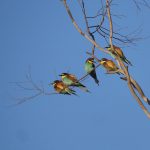
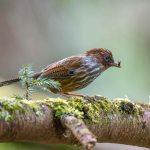

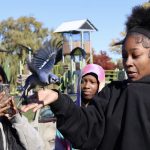
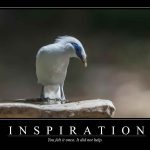
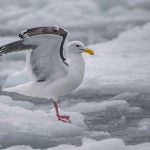
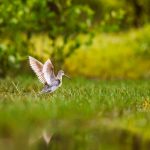
Wow, what a wonderful and gorgeous variety of birds! I should have visited the Dry Tortugas while I still lived in Florida!
@Mia McPherson I know – I can’t believe I waited this long either!
Pretty sick! I have always wanted to go there. Great pix.
Well, you had a wonderful Fort Jefferson birding experience – and t is a treat to bird with Adrian. Fort Jefferson in April is on my bucket list now!
AMAZING!!! Good job you are not listing with us this year or I fear you may be a long way in front! I lived in Florida in 1985-86 and should have done this! Oh well, we are not as young as you, but there’s time left for us to visit I am sure! 🙂
James, you must have birded Key West and then visited Garden Key right after my group. In fact, I recognize that nighthawk! We thought it might be Antillean too, but it never spoke to us. Seeing the weird Hooded and Lincoln’s Sparrow are like seeing old friends. But, in 3 days of birding, we did not have a Wilson’s Warbler. So, interesting which birds stay and which birds come and go.
@Donna S: Yes, it really is fascinating. In fact, we only saw the weird Hooded for one day and it was not present the next. Seems most birds leave as soon as conditions are favorable. But some seem to need more time to refuel.
Great video! Correct me if I’m wrong but from 11:13-11:18 the shot of “both species” of kingbird together, looks like it’s actually two Eastern Kingbirds?
@Jason G: Good eyes! You are 100% correct. I had both species together (I have now included the pic in the post above) and the Grey left and caught an insect. It ate it and then left and was obviously replaced by an Eastern who also had an insect whilst I wasn’t looking. When I edited this together all I remembered was the two together and I must’ve grabbed the wrong clip. Great job spotting this!!
Wow, what a trip! Thanks for sharing it.
Happy Belated Birthday,
It was a pleasure birding with you and Adrian during this Bucket List trip and I never thought you to be old and dying, especially when we found that Blue-winged Warbler at Indigenous Park. Fort Zachary was fantastic. The Dry Tortugas are truly magical. Thanks for sharing your photos and video. Wes Biggs and FL Nature Tours were the best birding hosts and leaders and way too fun. Good luck with your next ventures!
@Diana Reed: Great meeting you guys too. Oh, and thanks for the Blue-winged! We wouldn’t have got it without you guys.
I think the Hooded is a Common Yellowthroat. The olive of the back is perfect, the yellow in the throat and the proportions of the bird say Yellowthroat (very short wings, short tail, long undertail coverts, bill and legs). Also the yellow throat. Interesting bird.
This is not a Common Yellowthroat for several reasons. Yellowthroats actually have relatively long tails in my limited experience. They also have plain olive backs rather than the richer dark-green olive on this bird. This bird was larger than a yellowthroat and its habits (flicking of tail) would indicate Hooded.